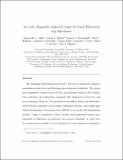An early diagenetic deglacial origin for basal Ediacaran “cap dolostones”
Abstract
The beginning of the Ediacaran Period (∼635 Ma) is marked by conspicuous dolostone units that cap Marinoan glacial deposits worldwide. The extent and sedimentary characteristics of the cap dolostones indicate that anomalous carbonate over-saturation coincided with deglacial sea-level rise and ocean warming. However, the geochemical variability within cap dolostones, both between continents, across single continental margins, and within individual stratigraphic sections has been difficult to reconcile with depositional models. Using a compilation of new calcium and magnesium isotope measurements in Marinoan cap dolostone successions worldwide, we show that the geochemical variability can be explained by early diagenetic dolomitization of aragonite along a spectrum of fluid- and sediment-buffered conditions. Dolostones from the outer platform formed under fluid-buffered conditions, whereas dolostones on the inner platform and foreslope environment formed under sediment-buffered conditions. This spatial pattern of dolomitizing conditions is consistent with buoyant recirculation of glacial seawater within carbonate platforms driven by the deglacial sea-level rise and development of a meltwater surface ocean. Using a numerical diagenetic model to evaluate the geochemical differences between sediment- and fluid-buffered cap dolostone units, we constrain the chemical and isotopic composition of both the dolomitizing fluid (glacial seawater [δ13C∼ 0–2‰]), the meltwater lens (δ13C∼−11‰), and the primary aragonite sediment (δ13C∼−6 to −3‰). These model end-members do not imply that primary geochemical variability did not exist but demonstrates that it is not necessary to change the chemistry of seawater to explain the global stratigraphic variability in the geochemistry of basal Ediacaran cap dolostones. Our results provide a novel framework for understanding the geochemical variability of cap dolostone units, including large excursions in carbon isotopes, and how this variability is the product of local diagenetic processes expressed globally in continental margin environments following the last Snowball Earth.
Citation
Ahms , A-S , Maloof , A , Macdonald , F , Hoffman , P , Bjerrum , C , Bold , U , Rose , C V , Strauss , J & Higgins , J 2019 , ' An early diagenetic deglacial origin for basal Ediacaran “cap dolostones” ' , Earth and Planetary Science Letters , vol. 506 , pp. 292-307 . https://doi.org/10.1016/j.epsl.2018.10.046
Publication
Earth and Planetary Science Letters
Status
Peer reviewed
ISSN
0012-821XType
Journal article
Description
ASCA acknowledges support from The Carlsberg Foundation. JAH acknowledges support from NSF grant no. IES1410317 and from National Science Foundation OCE CAREER Grant No. 1654571. ASA and CJB acknowledges support from the Danish National Research Foundation (Grant No. DNRF53).Collections
Items in the St Andrews Research Repository are protected by copyright, with all rights reserved, unless otherwise indicated.

